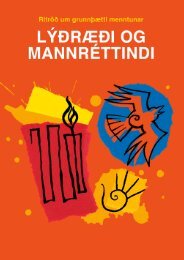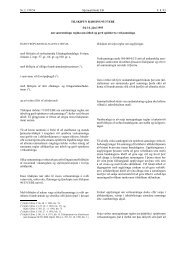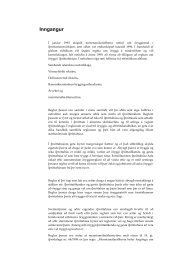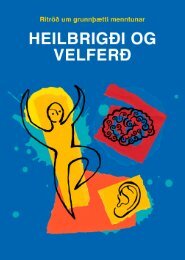Arts and Cultural Education in Iceland : Professor Anne Bamford
Arts and Cultural Education in Iceland : Professor Anne Bamford
Arts and Cultural Education in Iceland : Professor Anne Bamford
Create successful ePaper yourself
Turn your PDF publications into a flip-book with our unique Google optimized e-Paper software.
For older pupils, there are electives <strong>in</strong> photography <strong>and</strong> film mak<strong>in</strong>g. Pupils from the school won a small photography<br />
<strong>and</strong> short film contest for 66° North. The filmmak<strong>in</strong>g elective is more popular with boys, whereas most other electives<br />
<strong>in</strong> the arts are more popular with girls.<br />
Assessment of the arts is done <strong>in</strong> the same way as all other assessment. The pupils receive a report twice a year <strong>and</strong><br />
the arts teacher writes a comment <strong>and</strong> can give a grade. The arts teachers also participate <strong>in</strong> the parent teacher<br />
<strong>in</strong>terviews. Drama is not taught but twice a year the school pupils put on a play. The pr<strong>in</strong>cipal of the school is a<br />
committed amateur actor <strong>and</strong> so takes the 3 oldest classes to make a play. He says, “The pupils really love it. It is a big<br />
production”.<br />
Class teachers are also encouraged to use creative ways to teach. Twice a year they get a visit from the “Music for All”<br />
programme. The school also pays for a small theatre group to visit the school once or twice a year. The pr<strong>in</strong>cipal<br />
comments, “The last group dealt with social issues. They were excellent <strong>and</strong> suitable for all ages. Even the teachers<br />
learnt from it.”<br />
The theatre groups charge between 40,000-60,000 ISK to come to the school. The school takes the pupils every<br />
second year to Reykjavik to visit the national gallery, art gallery <strong>and</strong> museums. The parents’ association pays for the<br />
pupils to go to an even<strong>in</strong>g at the theatre dur<strong>in</strong>g their visit.<br />
The pupils usually prefer to see a musical. The school is also actively <strong>in</strong>volved <strong>in</strong> the national talent quest competition<br />
<strong>and</strong> do a series of <strong>in</strong> school ‘talent quests’ as a lead <strong>in</strong>to the bigger event.<br />
The pr<strong>in</strong>cipal comments, “I am quite surprised when I describe it how much we are actually do<strong>in</strong>g <strong>in</strong> the arts. We have<br />
quite a lot of foreign students, ma<strong>in</strong>ly Filip<strong>in</strong>o <strong>and</strong> Polish <strong>and</strong> we cater for them through the arts. The arts really work<br />
as they connect people. It is a common <strong>in</strong>ternational language. All students love dance <strong>and</strong> music. We try to <strong>in</strong>tegrate<br />
creativity <strong>in</strong>to all th<strong>in</strong>gs that we do, but it is not always a success. The pr<strong>in</strong>cipal f<strong>in</strong>ishes, “Parents say they are very<br />
happy with the school”.<br />
Vignette 5.4.3.2 Everyone s<strong>in</strong>gs along <strong>in</strong> the school<br />
The small compulsory school is erected by the banks of a frozen river. It has 36 pupils between the ages of six <strong>and</strong> 16<br />
years <strong>and</strong> seven pupils under five. They are mostly from the three towns that used to exist <strong>and</strong> come from a radius of<br />
about 40 kilometres, to get to the school. School buses go out each day <strong>and</strong> pick the children up.<br />
Art is <strong>in</strong> all grades. There are four groups across the whole school. Group one has students <strong>in</strong> grades one to three,<br />
group two grades four to six, group three grades seven to eight, <strong>and</strong> group four grades n<strong>in</strong>e to ten. Group one gets<br />
four classes <strong>in</strong> art <strong>and</strong> one <strong>in</strong> music, each class is 40 m<strong>in</strong>utes long. They also have two classes <strong>in</strong> wood <strong>and</strong> textiles <strong>and</strong><br />
they swap around hav<strong>in</strong>g half a year of wood <strong>and</strong> half a year of textiles. They also have cook<strong>in</strong>g but the Pr<strong>in</strong>cipal said<br />
he was unsure if it is part of the arts or not. In the second group they do two classes <strong>in</strong> art, one for music, <strong>and</strong> one also<br />
for textile <strong>and</strong> wood which once aga<strong>in</strong> is spilt across the year. They do two classes <strong>in</strong> cook<strong>in</strong>g. In the grade five they<br />
also have two classes a week, additional, <strong>in</strong> Lego build<strong>in</strong>g <strong>and</strong> can choose this <strong>and</strong> other subjects over the three<br />
semesters. Group three has one lesson a week <strong>in</strong> music, <strong>and</strong> four lessons where they can have electives. Most have to<br />
choose one elective for one semester then move to the next. The most popular electives are wood, textiles, digital<br />
photography, sports <strong>and</strong> cook<strong>in</strong>g.<br />
A quote from the school pr<strong>in</strong>cipal <strong>in</strong>dicated that “the pupils are do<strong>in</strong>g a lot of <strong>in</strong>tegrated learn<strong>in</strong>g, there is a lot of<br />
work<strong>in</strong>g together, the art teacher <strong>and</strong> the regular teachers work together. For example we are learn<strong>in</strong>g about w<strong>in</strong>d, so<br />
what we did was we <strong>in</strong>tegrated this with history <strong>and</strong> with art, we work on related theme topics.<br />
We do have specialist teachers, a specialist wood teacher, a specialist arts teacher who comes from America, a textile<br />
specialist <strong>and</strong> a music specialist. But the music specialist has 30 years of experience but not formally qualified. Most of<br />
our teachers are not officially qualified because it is hard to attract teachers <strong>in</strong> this remote area.<br />
We are also a base for a music school, which we hold <strong>in</strong> the basement of the school. About 80 to 90 percent of our<br />
pupils do extra music. There are two teachers, <strong>and</strong> very high amounts of our students go. The parents have to pay for<br />
the <strong>in</strong>struments.<br />
Once a week the whole school <strong>and</strong> the teachers meet together <strong>and</strong> s<strong>in</strong>g a song. We make song books for the school,<br />
<strong>in</strong>clud<strong>in</strong>g some popular Icel<strong>and</strong>ic folk songs. This was a new <strong>in</strong>itiative <strong>in</strong> the school <strong>and</strong> they all liked it. Everyone s<strong>in</strong>gs<br />
along <strong>in</strong> the school even the older children s<strong>in</strong>g along.<br />
We’ve also started a dance group, someone came from the cultural museum <strong>and</strong> they taught dance, it was l<strong>in</strong>ked to<br />
history as it was all about eat<strong>in</strong>g traditional Icel<strong>and</strong>ic foods <strong>and</strong> show<strong>in</strong>g the old dances. We all danced <strong>and</strong> it was<br />
115



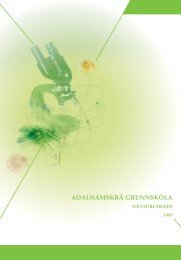
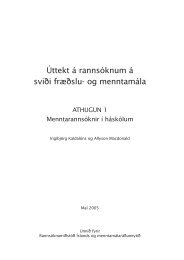

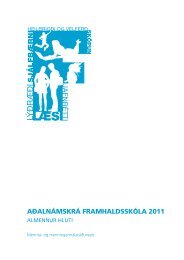
![Aðalnámskrá tónlistarskóla : rytmÃsk tónlist [Eingöngu á rafrænu formi]](https://img.yumpu.com/50843672/1/184x260/aaalnamskra-tanlistarskala-rytma-sk-tanlist-eingangu-a-rafranu-formi.jpg?quality=85)
